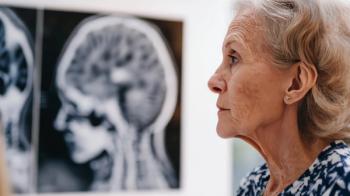
Sural Nerves Implicated in ALS
amyotrophic lateral sclerosis, ALS, sural nerves, sural nerve involvement
Read any overview of amyotrophic lateral sclerosis (ALS) and you will learn that ALS affects motor nerves but not sensory nerves-but is this correct? A study by an investigative team in the Department of Neurology at Emory University in Atlanta suggests that sural nerves indeed are affected.In reviewing cases entered into the Emory University motor neuron disease registry between 1997 and 2004, the team discovered that sural sensory nerve action potential (SNAP) amplitudes were abnormal in 36.4% (8 of 22) of sural nerve biopsies, with a mean reduction in amplitude of 35.5%. Furthermore, pathologic abnormalities, predominantly affecting large-caliber myelinated fibers, were present in 91% (21 of 22) of these biopsy specimens.SNAP amplitudes also were analyzed in 81 patients with ALS whose records included data on sural nerve studies but not biopsies. SNAP amplitudes were reduced in 21aeor about a quarter (25.9%)aeof these patients. The mean reduction in amplitude was 49.6%. "Age and gender distributions as well as the frequency of sural sensory nerve conduction abnormalities and mean reduction in SNAP amplitudes were similar in the [biopsy] and [no biopsy] groups, suggesting that the patients undergoing biopsy were representative of the broader ALS population," the team explained in a poster that they presented last year at the annual meeting of the American Neurological Association in San Diego.A CLINICAL PROBLEM OR NOT?A handful of small studies have emerged since the 1980s suggesting that sural nerves might be affected by ALS. Some suggest that an effect is present but subtle if not minor,1,2 while others suggest that sural nerve involvement is significant.3,4Indeed, a very early study3 of 5 patients with "pseudopolyneuropathic" ALS generated findings similar to those of the Emory researchers. Sural nerve biopsies demonstrated "a severe loss" of myelinated fibers, with large fibers being most affected. In addition, "wallerian-like degeneration" was evident in teased fibers. The authors of the early study concluded that axonal degeneration of the sural nerve is evident in pseudopolyneuropathic forms of ALS. Another study that found abnormalities in sensory as well as motor nerve conduction velocities in patients with ALS suggested that nerve entrapment might be a contributing cause of sensory nerve involvement but that other factors, yet unexplained, also might be involved.5In addition to capturing evidence of ALS-associated axonal degeneration of sural nerves, the Emory team identified 4 patterns of degeneration: irregular myelin; wallerian, which was the most predominant pattern; segmental demyelination; and intermodal variability of more than 50%. A blind reexamination by 3 neuromuscular pathologists of sural nerve biopsy specimens from patients both with and without ALS was undertaken to determine this finding as well as confirm the diagnosis. Patterns were elicited by teased fiber analysis of 7 biopsies in which demyelination was suspected (6 from patients with ALS and 1 from a control) before unblinding.A RESEARCHER SPEAKSApplied Neurology recently posed several questions to the lead author of the study, Mustafa Hammad, MD, DO, a fellow at Emory during the time of the study and currently an attending physician at Bay Medical Center in Panama City, FL. The exchange appears below in Q&A format:AN: Why did you and your colleagues decide to embark on this study?Hammad: ALS is a progressive degenerative disease of the upper and lower motor neurons. Although it is thought to be a pure motor neuron disease, many autopsy studies have shown involvement of the non-motor pathways, both in the familial and in sporadic forms. Sensory nerve involvement was suggested decades ago when Bertrand and van Bogaert6 mentioned in their neuropathology report of Charcot ALS that in the peripheral nerve "the sensory fibers are as poor in myelin as are motor fibers."Since then, sensory nerve involvement has been suggested by a number of morphologic, electrophysiologic, and quantitative sensory studies. However, those studies had small sample size, inconsistent results, and none reported both physiologic and pathologic changes in the same patients. The objective of this study was to assess the pathologic and electrophysiologic sensory nerve abnormalities in patients with ALS.AN: How did the neuropathologists "score" in identifying the pathologic biopsy specimens?Hammad: We had 22 ALS and 12 control sural nerve biopsies. The controls are biopsy specimens from patients with myopathy, fatigue, generalized weakness, or other nonspecific symptoms. Those control biopsies were interpreted as normal when they were initially read. All biopsies were randomly mixed and reinterpreted by 3 neuromuscular neuropathologists blind to the clinical diagnosis. The pathologists reviewed the biopsies and reported the results of 20 parameters as well as giving a final diagnosis (abnormal or normal) for each of the biopsies. Each parameter was scored from 0 (being normal) to 4 (most abnormal).The majority opinion prevailed regarding the presence or absence of a pathologic finding. Seven biopsy specimens (6 ALS and 1 control), suspected of having demyelination, were teased before the diagnoses were unblinded. Five ALS and 5 control biopsy specimens were then randomly chosen for morphometry.AN: I've seen notes on ALS message boards in which patients claim that they have sensory involvement. Responding clinicians patently answer that ALS only affects motor nerves. Why, in your opinion, haven't more clinicians given credence to patient reports of sensory deficits?Hammad: My guess is that we recognize patterns of symptoms/signs with which we are familiar and that we perceive what we expect to see rather than what we actually see. Having said that, it is important to emphasize that the sensory symptoms are minor in comparison to the motor deficits.AN: Does sural nerve involvement have the potential to significantly compound the effects of motor nerve involvement in terms of quality of life/activities of daily living?Hammad: In the overwhelming majority of patients with ALS, sensory symptoms, such as pain, numbness, and tingling sensations, are not significant and do not impact the quality of life and activities of daily living. However, in rare situations, those symptoms, occurring alone or in conjunction with some motor deficits, might interfere with quality of life and daily living.AN: What are the clinical implications of your study and the implications about how patients and their families are counseled about ALS?Hammad: The clinical implications are likely limited and will not change information communicated to families, but the data may be relevant to how we think about the pathogenesis of ALS, specifically with regard to the search for an explanation for the selective involvement of motor neurons. That is to say, the selectivity for motor neurons is a relative one with other systems bearing some of the brunt of the disease. Our findings also might be relevant in diagnosing the disease. Frequently, when sensory abnormalities (on history, examination, and neurodiagnostic or neuropathologic testing) are noted, ALS becomes a less likely diagnosis or, in some instances, is excluded.AN: What additional research is needed to further explore the effect of ALS on sensory nerves and the relationship between sensory and motor nerve degeneration in ALS? Do you think that a better understanding of sural nerve involvement in ALS will aid in developing pharmacologic agents to manage the disease?Hammad: A prospective study that assesses sensory modalities (using history, examination, and electrodiagnostic and neuropathologic testing) can be done by following patients from the time of presentation throughout the course of the disease. It is hard to say whether or not better understanding of sural nerve involvement will lead to a better understanding of ALS. However, knowing the details and the full manifestations of the disease cannot but help improve our understanding. Improving our understanding of a disease provides us with a better chance of finding a better management and possibly a cure.REFERENCES1. Theys PA, Peeters E, Robberecht W. Evolution of motor and sensory deficits in amyotrophic lateral sclerosis estimated by neurophysiological techniques. J Neurol. 1999;246:438-442.2. Shefner JM, Tyler HR, Krarup C. Abnormalities in the sensory action potential in patients with amyotrophic lateral sclerosis. Muscle Nerve. 1991;14:1242-1246.3. diTrapani G, David P, La Cara A, et al. Morphological studies of sural nerve biopsies in the pseudopolyneuropathic form of amyotrophic lateral sclerosis. Clin Neuropathol. 1986;5:134-138.4. Gregory K, Mills K, Donaghy M. Progressive sensory nerve dysfunction in amyotrophic lateral sclerosis: a prospective clinical and neurophysiological study. J Neurol. 1993;240:309-314.5. Schulte-Mattler WJ, Jakob M, Zierz S. Focal sensory nerve abnormalities in patients with amyotrophic lateral sclerosis. J Neurol Sci. 1999;162:182-193.6. Bertrand I, van Bogaert L. Rapport sur la sclerose laterale amyotrophique. Rev Neurol (Paris). 1925;1:779-806.
Newsletter
Receive trusted psychiatric news, expert analysis, and clinical insights — subscribe today to support your practice and your patients.















